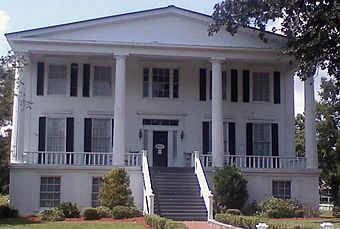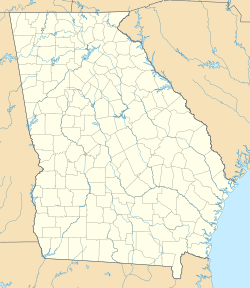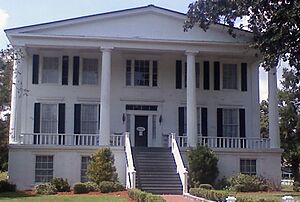Orange Hall (St. Marys, Georgia) facts for kids
Quick facts for kids |
|
|
Orange Hall St. Marys, Georgia
|
|
|
U.S. Historic district
Contributing property |
|

Orange Hall
|
|
| Location | 311 Osborne St., St. Marys, Georgia, United States, within the St. Marys Historic District |
|---|---|
| Built | 1830 |
| Architectural style | Greek Revival |
| Part of | St. Marys Historic District (Georgia) (ID76000609) |
| NRHP reference No. | 73000613 |
| Added to NRHP | May 7, 1973 |
Orange Hall, built around 1830, is a historic house located at 311 Osborne Street in St. Marys, Georgia, United States. It's part of the St. Marys Historic District in Camden County. This important building was added to the National Register of Historic Places on May 7, 1973. In 2011, Orange Hall was even named one of Georgia's ten most endangered historic sites by the Georgia Trust for Historic Preservation, meaning it needed special care to keep it from falling apart.
Contents
What Makes Orange Hall Special?
Orange Hall is a great example of a building designed in the Greek Revival style. Imagine ancient Greek temples, and you'll get an idea of this style! It's a wooden house with special siding called clapboard. It was one of the first buildings in America to use this Greek Revival design.
The house got its name because it used to be surrounded by many orange trees. Some of its cool features include:
- It has two stories.
- It has a sloped roof called a gabled roof.
- There are chimneys inside the house.
- The main entrance is in the middle of the front, with windows on the sides and above the door.
- A large, fancy porch with columns, called a portico, is at the front.
Orange Hall's Early History
The land where Orange Hall stands today was first given to William Ashley in 1787. He was one of the twenty people who helped start the town of St. Marys. Later, in 1826, the land was split, and the northern part was sold to a wealthy man named John Wood and a minister named Horace Southworth Pratt.
Building the House
Horace Southworth Pratt was a Presbyterian minister who arrived in St. Marys around 1820. He started the First Presbyterian Church of St. Marys in 1822 and married John Wood's daughter, Jane, in 1823. Sadly, Jane died in 1829, before Orange Hall was even built.
Pratt stayed in St. Marys and got married again a few years later. The construction of Orange Hall was finished in 1838. A skilled builder named Isaac Slayton was the master carpenter for the project. In 1839, Pratt, who had studied at Yale and Princeton universities, became a professor at the University of Alabama. He left Orange Hall behind. It's believed that General Duncan Lamont Clinch might have lived there after Pratt left. Pratt passed away in 1840 and never returned to Orange Hall.
Who Lived in Orange Hall?
After Horace Southworth Pratt left, Orange Hall was sold at a public auction in 1846 to James Mongin Smith, a rich farmer from South Carolina. Over the years, many different people owned this historic house:
- 1856: Francis Adams, who was the Mayor of St. Marys.
- 1866: Elizabeth and Joseph Ryals.
- 1869: Silas Fordham, a town supervisor and farmer from New York. He used Orange Hall as a place to stay during the winter.
- 1911: Joel Lee Sweat, who was a judge, a representative, and a state senator.
- 1919: James Howard Becker, who made automobiles.
- 1925: George and Ruth Fryhofer. They didn't spend much time in St. Marys and even lost the house for a short time because they didn't pay their taxes.
- 1933: Effie G. Townsend. During World War II, she had a tough time and turned the upper floors of the house into apartments to make money.
- 1949: Faye Kelly, Effie Townsend's daughter. She sold off two parts of the original land.
- 1951: St Marys Kraft Corporation. This company bought the house to provide homes for its paper mill employees for ten years.
- 1961: The City of St. Marys. The city agreed to rename the building the "Gilman Civic Center" and use it as a library for the community.
Saving Orange Hall
During the 1960s, Orange Hall started to fall apart. But in 1975, many groups and people came together to save and fix up the building. The City of St. Marys, the local Chamber of Commerce, and the Gilman Paper Company all helped.
Work began in 1978. Interestingly, skilled high school students who were unemployed at the time helped with the repairs. This was because the grant money for the project required using unemployed workers. The project was very successful and finished in 1980, making Orange Hall beautiful again.
Later, in 1982, a Naval Reserve Commander named John K. Mott created a big plan to restore the property even more. However, there wasn't enough money to do everything he suggested. In 1983, a group of Navy Reservist Seabees (who are military construction workers) helped with more repairs and rebuilding during their summer training. Their efforts helped keep Orange Hall in good shape for future generations.




